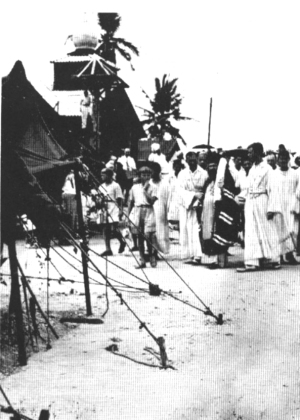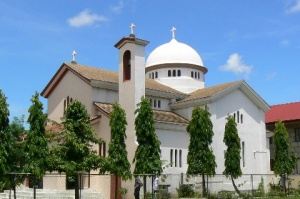Difference between revisions of "Orthodoxy in the Philippines"
PedroPenduko (talk | contribs) (→1600s - Greek Orthodox Christians: additonal extracts from "Historia de Philippinas" by the 18th century Jesuit Historian Murillo Velarde. Russians & Syrians were not mentioned this account.) |
PedroPenduko (talk | contribs) (→Arrival of Orthodoxy: citations from Blair & Robertson's The Philippine Islands 1493-1898 (Cleveland,Ohio, 1906)) |
||
| Line 10: | Line 10: | ||
== Arrival of Orthodoxy == | == Arrival of Orthodoxy == | ||
===1600s - Greek Orthodox Christians=== | ===1600s - Greek Orthodox Christians=== | ||
| − | It appears that the Greeks were the first Orthodox Christians on the island. An eighteenth century document written by a Jesuit historian describing their | + | It appears that the Greeks were the first Orthodox Christians on the island. An eighteenth century document written by Murillo Velarde, a Jesuit historian describing their Order’s missionary labors in the Philippines, records the presence of Greek settlers in the Philippine capital city of Manila as early as 1618 (Blair & Robertson's The Philippine Islands 1493-1898, Cleveland, Ohio: 1906, Vol. XLIV, p. 27). [http://merlot.umdl.umich.edu/cgi/t/text/pageviewer-idx?c=philamer;cc=philamer;q1=morenos;rgn=full%20text;idno=afk2830.0001.044;didno=AFK2830.0001.044;view=image;seq=31;page=root;size=s;frm=frameset;] |
| + | |||
| + | In his book ''Historia de Philipinas'' (published in Manila, 1749), the Jesuit historian Velarde wrotes: "I believe that there is no city in the world in which so many nationalities come together as here....There are a considerable number of Armenians, and some Persians; and Tartars, Macedonians, Turks, and Greeks....so that he who spends an afternoon on the ''tuley'' or bridge of Manila will see all these nationalities pass by him, behold their costumes, and hear their languages - something which cannot be done in any other city in the entire Spanish monarchy, and hardly in any other region in all the world." | ||
| + | (Cited in Blair & Robertson's The Philippine Islands 1493-1898, Cleveland, Ohio: 1906, Vol. XLIV, p. 29). [http://merlot.umdl.umich.edu/cgi/t/text/pageviewer-idx?c=philamer;cc=philamer;q1=morenos;rgn=full%20text;idno=afk2830.0001.044;didno=AFK2830.0001.044;view=image;seq=33;page=root;size=s;frm=frameset;] | ||
===1930s - Russian Orthodox Christians=== | ===1930s - Russian Orthodox Christians=== | ||
Revision as of 04:01, December 5, 2007
This article seeks to be a clearinghouse of information and links regarding the history and state of Orthodox Christianity in the Philippines.
The current Orthodox presence in the Philippines is minimal. However, early in the 20th century a small Russian parish, exclusively for Russian nationals, once existed in Manila, the capital city of the Philippines. The presence of this Russian parish ceased to exist after the Second World War. Another Orthodox parish under the jurisdiction of the Ecumenical Patriarchate was founded in Manila during the early 1990s.
Contents
Beginnings of Christianity in the Philippines
Christianity was first introduced to the Philippines in the 16th century by Spain, when the Philippines became its colony. Until the Philippine Revolution of 1896, it was illegal for any non-Roman Catholic church to establish itself in the Philippines. The Archbishop of Manila served as both representative of the Spanish Inquisition and, during the absence of the governor-general, the Spanish Crown.After fighting a bloody revolution against Spain, the Philippines then fought another war for its independence against the United States. However, the Philippines was annexed by the United States in 1898 and remained a colony until 1946. Religious tolerance was then instituted. The new American governor-generals then encouraged the spread of the Episcopal Church through government donations of land.
Arrival of Orthodoxy
1600s - Greek Orthodox Christians
It appears that the Greeks were the first Orthodox Christians on the island. An eighteenth century document written by Murillo Velarde, a Jesuit historian describing their Order’s missionary labors in the Philippines, records the presence of Greek settlers in the Philippine capital city of Manila as early as 1618 (Blair & Robertson's The Philippine Islands 1493-1898, Cleveland, Ohio: 1906, Vol. XLIV, p. 27). [1]
In his book Historia de Philipinas (published in Manila, 1749), the Jesuit historian Velarde wrotes: "I believe that there is no city in the world in which so many nationalities come together as here....There are a considerable number of Armenians, and some Persians; and Tartars, Macedonians, Turks, and Greeks....so that he who spends an afternoon on the tuley or bridge of Manila will see all these nationalities pass by him, behold their costumes, and hear their languages - something which cannot be done in any other city in the entire Spanish monarchy, and hardly in any other region in all the world." (Cited in Blair & Robertson's The Philippine Islands 1493-1898, Cleveland, Ohio: 1906, Vol. XLIV, p. 29). [2]
1930s - Russian Orthodox Christians
An influx of Russian emigrees fleeing the Soviet regime occured during the American colonial regime. In 1935, a Russian parish was established in Manila, and the Patriarch of Moscow and All Russia appointed Father Mikhail Yerokhin as vicar. The Episcopal Church then permitted Fr. Mikhail to use the north transept of their cathedral for worship. In 1937, the first Orthodox church was built and was named after the Iberian Icon of the Mother of God. This also became the first Orthodox altar in the Philippines. Later, both the Episcopal Cathedral and the Russian Orthodox church in Manila were destroyed during the Second World War.In 1949, 5,500 Russian Orthodox from China, including then-Archbishop John Maximovitch, were relocated to Tubabao in the south central Philippines by the International Refugee Organization and with the permission of the newly independent Republic of the Philippines. Abp. John Maximovitch then established a wooden church, orphanage, and other buildings in Tubabao exclusively for the Russian refugees.
Tubabao, however, was (and still is) an underdeveloped island which is humid, prone to typhoons, and at times inaccessible due to the ocean conditions. When a Russian commented on their fear that a typhoon would destroy their camp to local Filipinos, they replied that there was nothing to worry about because “your holy man blesses your camp from four directions every night.” There were no typhoons or floods while Abp. John was there.
Abp. John Maximovitch did not preach the Orthodox faith to the native inhabitants of the Philippine islands. No Filipino was baptized, chrismated, ordained or consecrated during his stay in the Philippines. Through the persistent lobbying of Abp. John to the U.S. Congress, the refugees were allowed to settle in the United States and Australia beginning in 1951.
1990s - Filipino Orthodox Christians
Around the beginning of the twentieth century, Greek sailors settled in Legaspi city on the island of Luzon about a century ago. Descendants of these Greek Orthodox Christian sailors now number no more than 10 families, who have kept their Greek surnames and many of whom have become distinguished public figures and intellectuals in the Philippines, including serving as the Greek consulate in Manila. Though they do not speak Greek, they were largely responsible for the re-establishment of an Orthodox presence in the Philippines through their encouragement of Filipino converts and the Hellenic Orthodox Foundation.
One of the first Greek Orthodox to arrive in the Philippines was Alexandros Athos Adamopoulos (aka Alexander A. Adamson), who came to Legaspi city in 1928. Together with his brother and cousin he co-founded Adamson University in 1932.Adamopoulos was appointed in 1942 by the Greek government to take charge of Greek interests in the Philippines. He was later promoted to the rank of Consul General of Greece.
In 1989, Adamopoulos saw the need to establish the first true Greek Orthodox church in the Philippines and thus established the Hellenic Orthodox Foundation Inc. Although he died in 1993 before the church was completed, the Orthodox Cathedral was finished in 1996 and is constructed in true Byzantine style, with all the interior furnishings imported from Greece, and is home to approximately 520 Filipino Orthodox and 40 expats[3]in Metro Manila, the capital city of the Philippines. This cathedral was consecrated by the Ecumenical Patriarch on March 5, 2000.
On April 20, 1990, a Filipino hieromonk, Fr. Vincentius Escarcha (a former Benedictine Abbot and a Roman Catholic priest for more than 20 years in Bajada, Cataingan, Masbate island), together with four nuns and faithful members of his community, were received into the Orthodox Church by Metropolitan Dionysios of the Greek Orthodox Metropolis of New Zealand and assisted by Bishop Sotirios of Zelon. On January 19, 1994, Metropolitan Dionysios, assisted by Bishop Sotirios, received by Holy Chrismation several Filipino Christians in Manila.
In 1996, the Orthodox Metropolitanate of Hong Kong and Southeast Asia was created for the needs of the faithful under the Church of Constantinople. In 2004, the Theotokos Orthodox Church in Bajada, Masbate was consecrated by His Eminence Metropolitan Nikitas of Hong Kong and South East Asia. At present, the nuns of the Theotokos Orthodox Monastery in Bajada run a kindergarten.
Orthodoxy in the Philippines today
Within the Ecumenical Patriarchate's Orthodox Metropolitanate of Hong Kong and Southeast Asia, there are currently three Filipino Orthodox priests in the Philippines under the spiritual jurisdiction of the Ecumenical Patriarchate of Constantinople and are administratively under an ecclesiastical vicar from Greece. In these communities, the Divine Liturgy and other Orthodox worship services are said in English, Greek and Filipino.Metropolitan Archbishop Paul (Saliba) appeared to have established the now defunct Antiochian Orthodox Christian Mission in the Philippines[4] within the Antiochian Orthodox Archdiocese of Australia and New Zealand (as per the Holy Synod of Antioch).
There are also some independent groups in the Philippines that use the term Orthodox in their names but are not in communion with or are recognized by any canonical Orthodox church.
External links
- Affiliate in the Philippines - Orthodox Metropolitanate of Hong Kong and South East Asia
- Official Website of the now defunct Antiochian Orthodox Christian Mission in the Philippines. See also Wikipedia Encyclopedia article [5].
- History of the First Filipino Orthodox Community in the Philippines by Rev. Dr. John Chryssavgis
- Ecumenical Patriarch Consecrates Annunciation Church in Manila
- Orthodox Church in the Philippines This is an independent organization not in communion with worldwide canonical Orthodoxy and headed by an excommunicated clergyman.
- Orthodox Patriarch Visits Fledgling Local Orthodox Church
- The Theotokos Orthodox Church & Monastery in Masbate (Information in an issue of The Censer)
- Major Events of Orthodoxy in the Philippines
- A priest's description of Orthodox missionary work in the Philippines
- Life of St. John Maximovitch
- The Greek Community in the Philippines
- Greeks in the Philippines and their contributions to the Filipinos
- The Philippine Islands, 1493-1803 by Emma E. Blair & James A. Robertson
| Parishes in South, East, and Southeast Asia | |||||||
|---|---|---|---|---|---|---|---|
| |||||||



